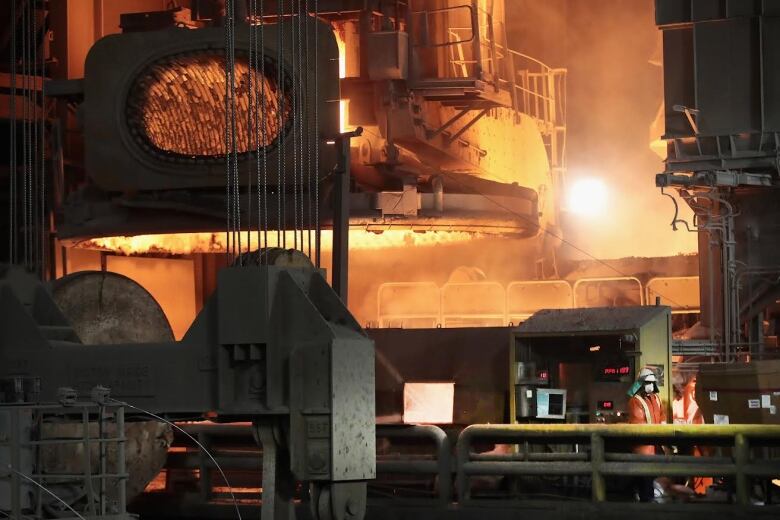Coal mining near Sparwood, B.C., faces uncertain future
Mining vital to Sparwood economy, but pressure mounting to get off the coal train

Members of Troy Cook's family havebeen miners for four generations. His great-grandfather dug through underground rock in Czechoslovakia.
The 52-year-old has worked for the Elkview Mine nearSparwood, B.C.,for 34 years. Coal is in his DNA.
"I'm super proud to be a coal miner," he says."It's been a great life. A lot of great people at the mine."
After all those years of extracting metallurgical coal used to make steel Cooksuffers from back pain and hearing problems.
Since 2000, he has been far from the frenzy of open-air quarrying and has instead become fully involved in the United Steelworkers Local 9346, which represents nearly 800 workers.
"I like helping people. When I was younger, I wanted to be an artist. But you got to pay the bills".
Cook is not optimistic about the future, especially because of automation. His employer, Teck Resources, is replacing truck drivers with self-driving trucks.
"They're already doing it. There are pits at the moment that are fully automated," he says.
"A lot of workers are concerned. The new hires now, [the company]don't give them any confidence that they're going to be there forever."
Cook believes he will be part of the last generation of miners in the region.

Global giant
Teck Resources is the world's second-largest exporter of metallurgical coal, essential for making steel used to build factories, wind turbines, buses, bicycles, and even kitchen utensils.
Coal mined from the Rockies is transported by rail to port terminals in Vancouver. The black rock is loaded onto ships heading for Asia. Of the 5.9 million tonnes of metallurgical coal sold by the company in the third quarter of 2021, 32 per cent washeaded to China.
Strong demand for raw materials sent the price of coal soaring in this year. Teck Resources posted a record adjusted profit of $1 billion at the end of its third quarter, seven times that of 2020.

Big boss of the region
With four open-pit mines in the Elk Valley, the company employs nearly 5,000 people Sparwood's population was only around 3,500 according to the 2016 census. Some come from Alberta and Quebec hoping for a better life.
"I don't know what I would do other than the mines,"says Frank Roesger, a 50-year-old Elkview loader operator and miner's son. He says those operations arecrucialfor the region.
"They support a lot of families, a lot of businesses".
The District of Sparwood is also reliant on mining: half of the municipal budget depends on it.
"We can provide good roads, recreation facilities so we can have young families willing to live here. We provide a great snow removal during the winter," says Mayor David Wilks.
Without the mines, the residential tax base would need tobe significantly higher to make up for the $3.3 million difference.
"That's massive,"says Wilks, who is convinced that he will no longer be around when the mines close.

Threat of innovation
Although some mines in the valley contain enough coal to remain active for another 30 years, some experts predict an earlier end to the sector.
Traditionally, coal processing is done in a furnace where itis heated at high temperatures to get rid of impurities beforeuse in steel-making. Chinese and Indian steel makers still operate this way.
Because of this process, the steel industry is the most heavy polluting industry in terms of carbon dioxide emissions, according to the International Energy Agency.
One innovation is getting a lot ofattentionbutcontrary to what some miners think, it's not hydrogen.There are "very efficient alternative processes" that can produce 30 times less greenhouse gases, according to Seth Feaster, an expert at the Institute of Energy Economics and Financial Analysis.
One example is recycled scrap metal burned in an electric arc furnace.

If China changes course
"In the United States, last year, about 70 per cent of all the steel was made with this electric arc furnace process," explains Feaster.
If China, the industry's biggest customer, imposes the use of this process to reduce its carbon footprint, Teck Resources' coal mines could become obsolete within 10 to 15 years, Feaster says.
"It could come sooner than what I think a lot of people are expecting".
Pressure from financial markets could also lower the production of metallurgical coal in Canada.
Colton Vessey, a University of Alberta doctoral student in environmental geochemistry and mineralogy, says electric arc furnaces can produce more steel with much less coal.
"There's a big push in the coal mining industry, and our steel making industry in particular, to move towards more green energy resources," he says.
Feaster says Teck Resources could even take advantage of the current high price of metallurgical coal to sell its mines to another company and focus on copper mining, which is expected to grow in the future.
In the long term, especially in Canada, he says "investors are much more sensitive about the climate impact of their investments."
Until innovation and green policies put an end to the industry, the district's mayorhopes his successors can turn the Elk Valley into a tourist destination.
It would require operators to restore a natural environmentthat has been mined for more than 100 years.












_(720p).jpg)


 OFFICIAL HD MUSIC VIDEO.jpg)
.jpg)



























































































